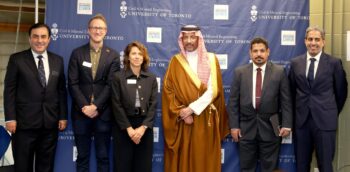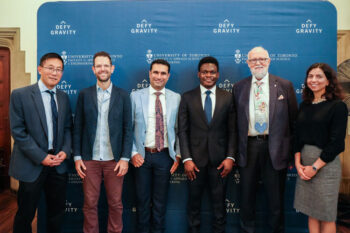A team of researchers at the University of Toronto Institute for Aerospace Studies (UTIAS) is celebrating 25 years of designing advanced micro- and nanosatellites for a broad range of missions — from scientific to commercial and government applications.
“Our laboratory engages in experimental technology research tied to real space missions,” says Professor Robert Zee, Director of the Space Flight Laboratory (SFL).
“We have many satellites under development at any given time to deliver innovative spacecraft for new and emerging applications worldwide.”
SFL employs what Zee calls a ‘teaching-hospital’ model. This approach enables graduate students to design and build low-cost satellites that are 3 to 500 kilograms in size, which are then implemented in sponsor-driven space missions with critical implications.
Since the laboratory’s inception in 1998, SFL researchers have launched 69 distinct micro- and nano-class satellites, with 27 additional projects currently under development or awaiting launch.
SFL has also accomplished many technological and scientific firsts during these past 25 years, including the building of Canada’s first space telescope, the MOST microsatellite.
Commissioned by the Canadian Space Agency and designed in collaboration with Dynacon, the 53-kg MOST microsatellite was used to study brightness oscillations in solar-type stars and was responsible for many astronomical discoveries.
SFL also built the BRITE Constellation — a fleet of six, cost-effective 7-kg nanosatellites. The mission was launched in 2013 through an equal partnership between Canada, Austria and Poland.
“BRITE is the world’s first space astronomy constellation. It performed scientific observations, looking at the most luminous stars that you can’t view with ground-based telescopes because of the geometry of the bright stars in space,” says Zee. “So far, there have been more than 100 papers written about astronomical discoveries made through this mission.”

Some of Zee’s projects make use of innovations in formation flight — that is, the coordination of multiple smaller satellites working together to accomplish the goals of a larger, more expensive satellite.
One of the earliest were CanX-4 and CanX-5, two nanosatellites built and launched in 2014 with funding from Defence Research and Development Canada, Canadian Space Agency, MDA, Ontario Centres of Innovation and the Natural Sciences and Engineering Research Council to demonstrate this capability at low cost.
Formation flying enables many advanced sensing capabilities using smaller satellites, says Zee, from radio frequency geolocation to high-resolution imaging interferometry — an approach to measurement that uses the interference of waves, such as light, radio and sound waves. For example, fleets of satellites can increase the effective aperture for space interferometry through distributed sensing over multiple smaller satellites, instead of using one large aperture in a single big satellite.
“Using two 7-kg spacecraft, CanX-4 and CanX-5, we demonstrated formation flying accuracies and position knowledge that could not previously be achieved at such a low price point,” he says. “This innovation enables individuals with small budgets to use formation flying in their missions.”
In the past three decades, SFL has built a productive relationship with the Norwegian Space Agency and the Norwegian Defence Research Establishment, which has led to the development and launch of seven distinct spacecraft for tracking ocean-going vessels, technology demonstration and scientific observation. The team developed Norway’s first satellite, AISSat-1, which launched in 2010 and operated in low-Earth orbit for 12 years, detecting ships and collecting messages from maritime vessels.
In April 2023, another satellite for the Norwegian Space Agency, NorSat-TD, was launched. This 30-kg spacecraft features a new ion propulsion system, a precise positioning payload that allows for more precise position determination than traditional GPS and optical communications technology from developers across Europe.
The satellite also features a very high frequency (VHF) data exchange system that allows two-way communication with ships. A key to making this system work was an SFL-developed deployable Yagi antenna with a deployed volume greater than the satellite itself.
The deployable VHF Yagi antenna technology on NorSat-TD grew out of a previous collaboration with Professor Sean Hum (ECE) to develop a similar deployable VHF Yagi for the NorSat-2 microsatellite. The VHF Yagi antenna provides the gain required for two-way communication with ships.
“Our team at UTIAS did the mechanical design and Professor Hum did the electrical and radio frequency design,” says Zee. “That was a very fruitful collaboration where we were able to mutually leverage each other’s knowledge and research to deploy something new and innovative into space for the first time globally.”
Zee believes that the team’s continued success is due to a consistent approach that focuses on sticking to its core principles. These include understanding the environment that they are going into and developing robust designs suited to it; testing at all levels of integration, from the unit level all the way up to the system level; and being open to working with various clients without shying away from what has never been done before.
“We have always been open to anyone needing a state-of-the-art, frontier-pushing satellite. We service the world — all sectors and all applications,” says Zee.
“We continue to be out-of-box, non-insular thinkers, open to working in different application areas and look forward to finding new ways to push the envelope of new technologies, algorithms and techniques to expand the frontier of space for all.”



